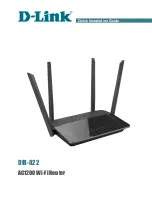
4
Chapter 2: Networking Basics
An Introduction to LANs
EtherFast Cable/DSL Router with 8-Port Switch
Chapter 2: Networking Basics
An Introduction to LANs
Simply put, a router is a network device that connects two networks together.
The Router connects your local area network (LAN), or the group of PCs in your home or office, to the Internet. The
Router processes and regulates the data that travels between these two networks.
The Router’s Network Address Translation (NAT) technology protects your network of PCs so users on the Internet
cannot “see” your PCs. This is how your LAN remains private. The Router protects your network by inspecting the
first packet coming in through the Internet port before delivery to the final destination on one of the Ethernet
ports. The Router inspects Internet port services like the web server, ftp server, or other Internet applications,
and, if allowed, it will forward the packet to the appropriate PC on the LAN side.
The Use of IP Addresses
IP stands for Internet Protocol. Every device in an IP-based network, including PCs, print servers, and routers,
requires an IP address to identify its location, or address, on the network. This applies to both the Internet and
LAN connections.
There are two ways of assigning IP addresses to your network devices.
A static IP address is a fixed IP address that you assign manually to a PC or other device on the network. Since a
static IP address remains valid until you disable it, static IP addressing ensures that the device assigned it will
always have that same IP address until you change it. Static IP addresses are commonly used with network
devices such as server PCs or print servers.
If you use the Router to share your cable or DSL Internet connection, contact your ISP to find out if they have
assigned a static IP address to your account. If so, you will need that static IP address when configuring the
Router. You can get the information from your ISP.
A dynamic IP address is automatically assigned to a device on the network. These IP addresses are called
dynamic because they are only temporarily assigned to the PC or other device. After a certain time period, they
expire and may change. If a PC logs onto the network (or the Internet) and its dynamic IP address has expired, the
DHCP server will assign it a new dynamic IP address.
Dynamic IP address
: a temporary IP
address assigned by a DHCP server.
Static IP address
: a fixed address
assigned to a computer or device that
is connected to a network.
NAT (Network Address Translation)
:
NAT technology translates IP
addresses of a local area network to a
different IP address for the Internet.
DHCP (Dynamic Host Configuration
Protocol)
: a protocol that lets one
device on a local network, known as a
DHCP server, assign temporary IP
addresses to the other network
devices, typically computers.











































